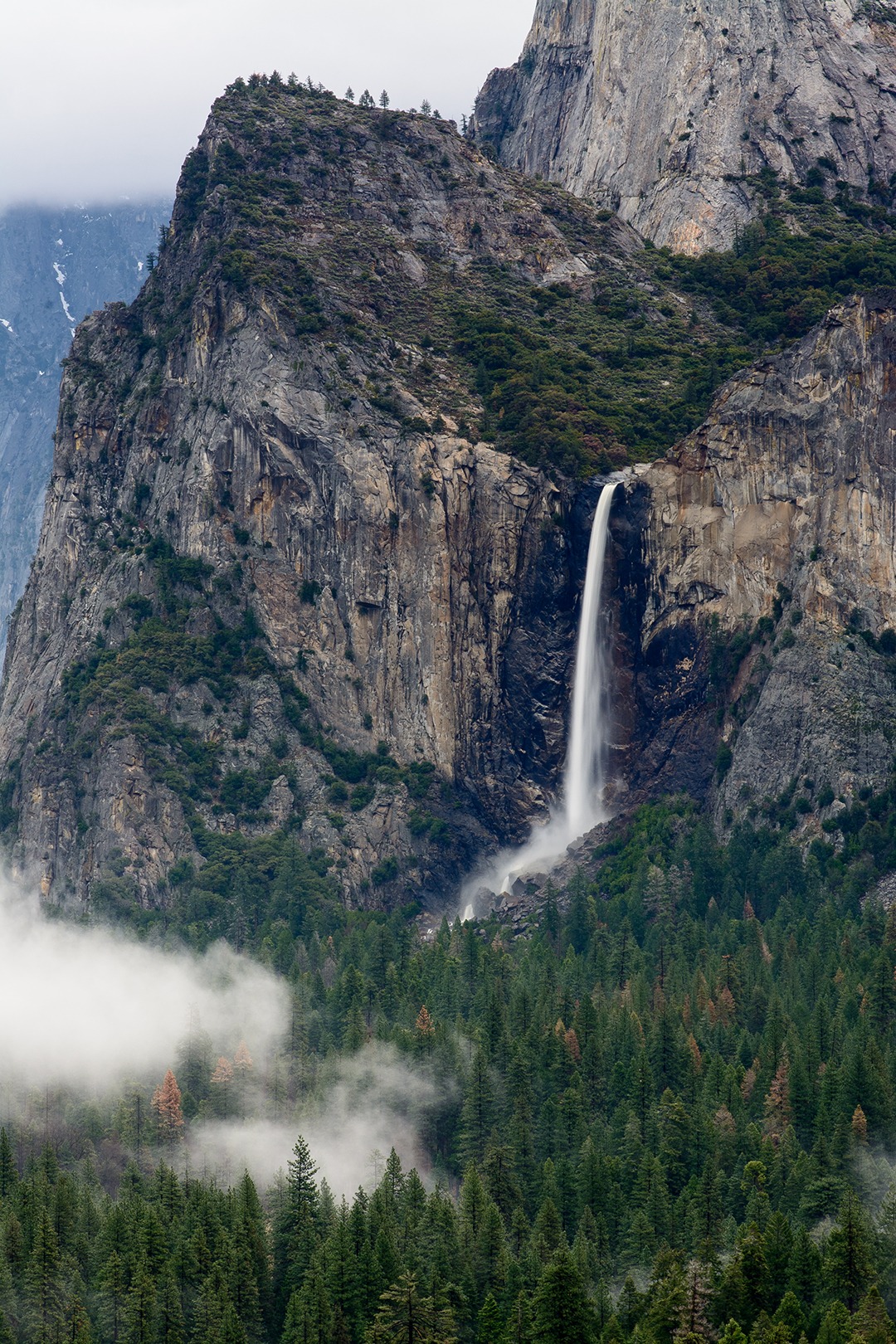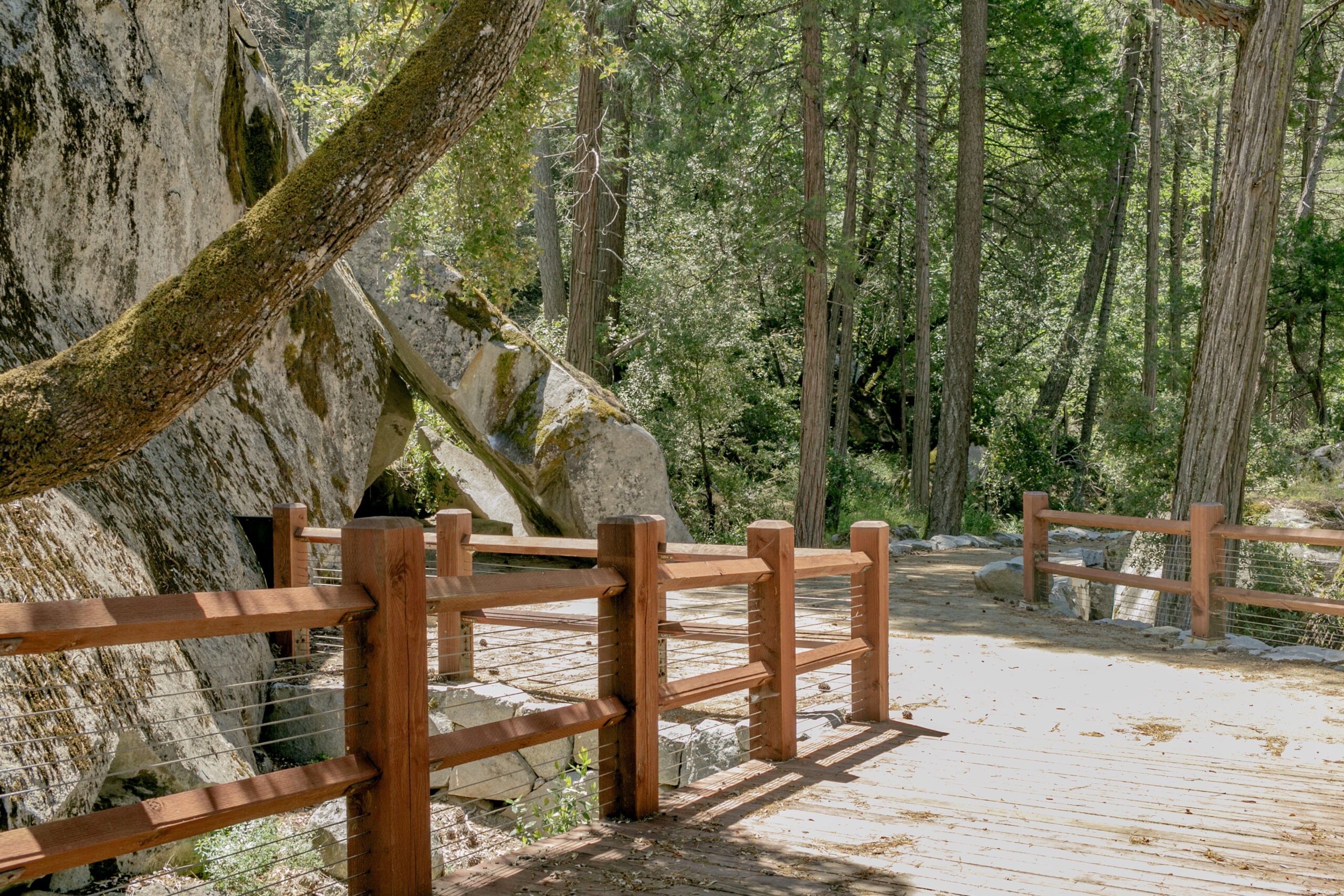Read about the multiyear restoration at Bridalveil Fall that improves the visitor experience, supported by Conservancy donors. This story appears in the Fall/Winter edition of the Yosemite Conservancy Magazine, and was written by Lauren Hauptman.
Protecting Pohono: Restoring the iconic west-end waterfall
 “Entering the valley, gazing overwhelmed with the multitude of grand objects around us, perhaps the first to fix our attention will be Bridal Veil, a beautiful waterfall on our right. Its brow, where it first leaps free from the cliff, is about 900 feet above us; and as it sways and sings in the wind, clad in gauzy, sun-sifted spray, half falling, half floating, it seems infinitely gentle and fine; but the hymns it sings tell the solemn fateful power hidden beneath its soft clothing.” —John Muir, 1912
“Entering the valley, gazing overwhelmed with the multitude of grand objects around us, perhaps the first to fix our attention will be Bridal Veil, a beautiful waterfall on our right. Its brow, where it first leaps free from the cliff, is about 900 feet above us; and as it sways and sings in the wind, clad in gauzy, sun-sifted spray, half falling, half floating, it seems infinitely gentle and fine; but the hymns it sings tell the solemn fateful power hidden beneath its soft clothing.” —John Muir, 1912
Is there a more magnificent sight to see at the west end of Yosemite Valley than Bridalveil Fall? John Muir didn’t seem to think so. And neither do millions of visitors who have gazed at the glorious 620-foot cascade.
Known as “Pohono” to Southern Sierra Miwuk Indians, Bridalveil Fall is framed by Leaning Tower and Cathedral Rocks. Bridalveil Creek, which feeds the waterfall, travels about 10 miles northwest from Ostrander Lake to Yosemite Valley. The tributary flows hundreds of feet up from the ground through a U-shaped channel with steep walls that were created by glaciers — a “hanging valley.” Water jumps the rim, crashing to boulders below into a network of stream channels that eventually join the Merced River.
The view of the fall from Tunnel View is astounding — but up until recently, the experience of visiting the
fall up close has been less than ideal. Thanks to our generous donors, the National Park Service, working in partnership with Yosemite Conservancy, embarked on a major, multiyear renovation at the site in 2019. The project will protect the area and enhance the visitor experience by reducing crowding and dispersing visitors; providing accessible, ADA-compliant trails and access; developing orientation and installing wayfinding and interpretation exhibits; and providing adequate parking, restroom facilities, trails, and viewing spaces.
 The project’s trail work, which is set to be completed in fall 2023, includes an elevated boardwalk spanning over wetlands and a seasonal stream channel to protect sensitive riparian habitat. Visitors will enjoy the expanded hiking possibilities along a new ADA-compliant loop trail that connects parking areas, the historic carriage road, and an additional viewing platform. The existing overlook, which was small and often crowded has been expanded nearly fourfold, providing visitors with informal seating options to pause, rest, and take in the stunning beauty of the fall plummeting from the valley rim above.
The project’s trail work, which is set to be completed in fall 2023, includes an elevated boardwalk spanning over wetlands and a seasonal stream channel to protect sensitive riparian habitat. Visitors will enjoy the expanded hiking possibilities along a new ADA-compliant loop trail that connects parking areas, the historic carriage road, and an additional viewing platform. The existing overlook, which was small and often crowded has been expanded nearly fourfold, providing visitors with informal seating options to pause, rest, and take in the stunning beauty of the fall plummeting from the valley rim above.
Improvements were made to area roads to accommodate traffic and improve safety. Most notably, a space dedicated to commercial buses provides a safe zone for passengers to disembark along South Side Drive. A new arrival plaza was constructed, and orientation and wayfinding were installed.
While the aesthetics of the plaza may not appear all that different, major improvements were made. Drainage was corrected to avoid springtime flooding, and utilities were installed to support a brand-new restroom (which replaced the old vault toilets), to be completed in fall 2023. The restroom will provide 16 stalls, and a water bottle-filling station.

In June of this year, a bronze plaque was installed at the site at Bridalveil Fall to recognize major donors. Image: Laurie Peterson
The final part of the Bridalveil project concerns “orientation,” which helps visitors land, get their bearings, and plan their hike. Orientation panels were installed at the two main access points to the Bridalveil area, along South Side Drive and at the main parking lot. Interpretive exhibits intended to share stories and information on natural and cultural resources will be installed in summer 2024. Stories of Tribal stewardship, past and present, will join information on plants and wildlife, the unique geological features of the hanging valley from which the fall tumbles, and the climbing history of the Leaning Tower rock formation adjacent to the fall.
Thanks to the generosity of Conservancy donors, the renowned waterfall that so captivated John Muir and many other visitors, will continue to inspire people long into the future.
